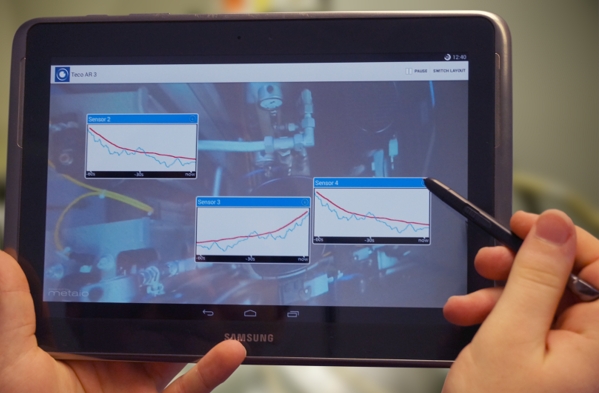
|
Fachbereich: Studien & Marktanalysen
Erstveröffentlichung: 24.04.2016 Ausgedruckt am: 30.07.2017 |
At a “smart” factory, machines reveal a number of data about themselves
Sensors measuring temperature, rotating speed or vibrations provide valuable information on the state of a machine. On this basis, worn parts can be exchanged in due time. A software developed by the Institute of Telematics of Karlsruhe Institute of Technology (KIT) helps the maintenance staff allocate the information transmitted by the sensor in a wireless manner to the point of measurement in the camera image. The sensor data are imported into the latest camera shot of the real machine.
Machine tools and production plants frequently are operated for several decades. Predictive maintenance is aimed at preventing an undesired outage, if possible. Wireless sensors in the machine help detect faulty parts at an early stage. They measure and transmit data that allow conclusions to be drawn by the maintenance technician as to whether gearwheels are worn, ball bearings are uneven or the pipe of a pump is plugged. “The operation concept allows for efficient direct troubleshooting,” KIT scientist Matthias Berning says. His development for user-friendly data access makes the sensor data, such as the vibration frequency, acceleration or temperature of a component, visible on the screen in real time. The data are displayed in the camera shot. Connecting lines show the point of measurement in the machine component. When the camera pans, these connecting lines follow. For this purpose, the electrical engineer specialized in information technology uses augmented reality (AR): Images of the real world are complemented by computer-supported information. When looking at the display of his tablet computer or smartphone, the maintenance engineer can directly allocate the data measured to the respective component. By a click, the data measured are represented in the form of tables or diagrams. In addition, the data are classified depending on which information is needed. As a rule, data of various measurement points have to be compared in order to detect a failure in complex machines. Direct spatial representation spares the engineer the trouble of allocating sensors and components using numbers or letters. The major question in Berning’s research project is: “How can the data obtained at the interface of man and computer be used such that man understands them?” Berning develops the operation concept within the framework of his doctoral thesis at the Chair of Pervasive Computing Systems headed by Professor Michael Beigl. Here, work focuses on the development and integration of modern information and communication technologies into the physical environment. The TECO research group that closely cooperates with industry to advance research and development of applied telematics is also part of this chair. Berning’s industry partner is the ABB Corporate Research Center. “The prototypes demonstrate that utilization of the data by interlinkage with the camera shot is feasible and reasonable,” Berning says. In view of growing amounts of data supplied by the “internet of things”, it is even more important now to adapt the wealth of information to the respective task in a user-friendly manner. Quelle: Karlsruhe Institute of Technology (KIT)
24.04.2016 | Autor
Kaido Einama
|
o-mag.ch - Fachinformationen ausschlißlich online
